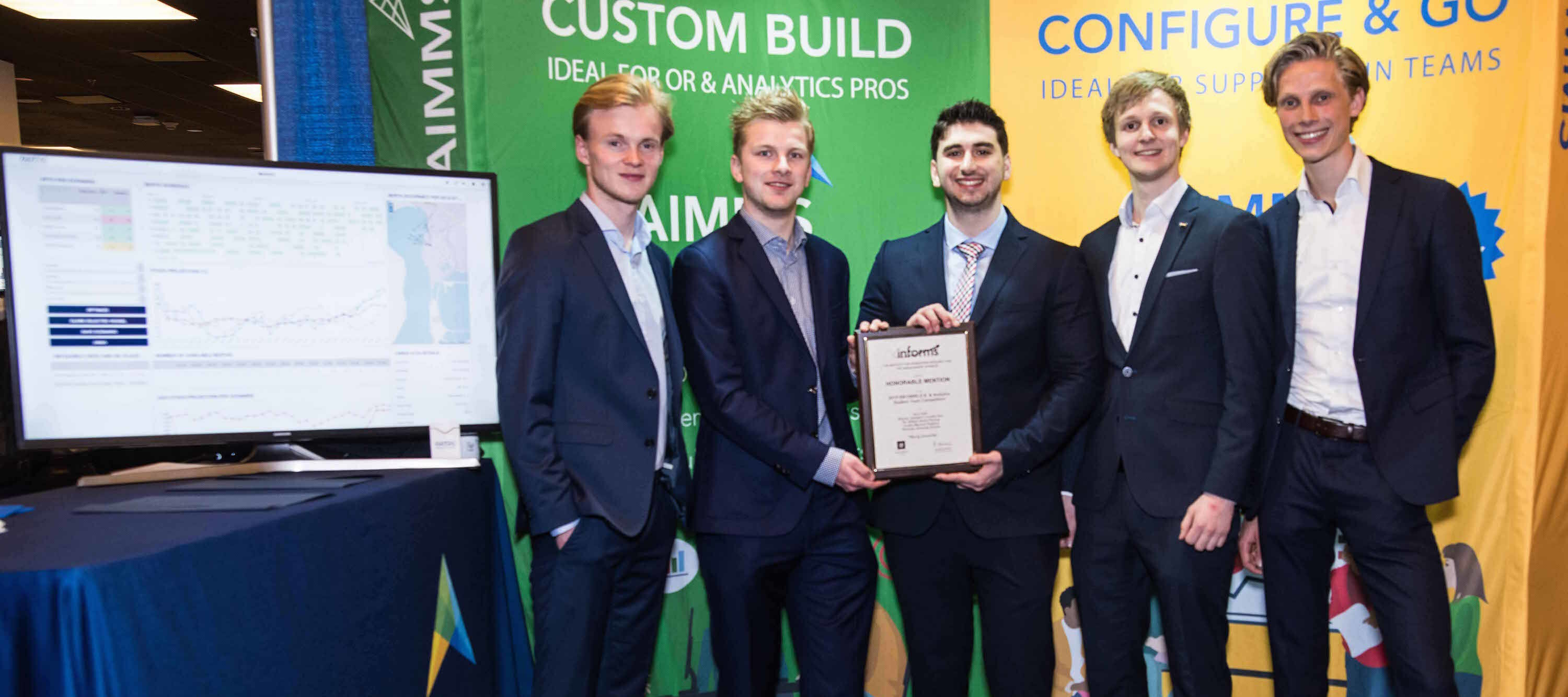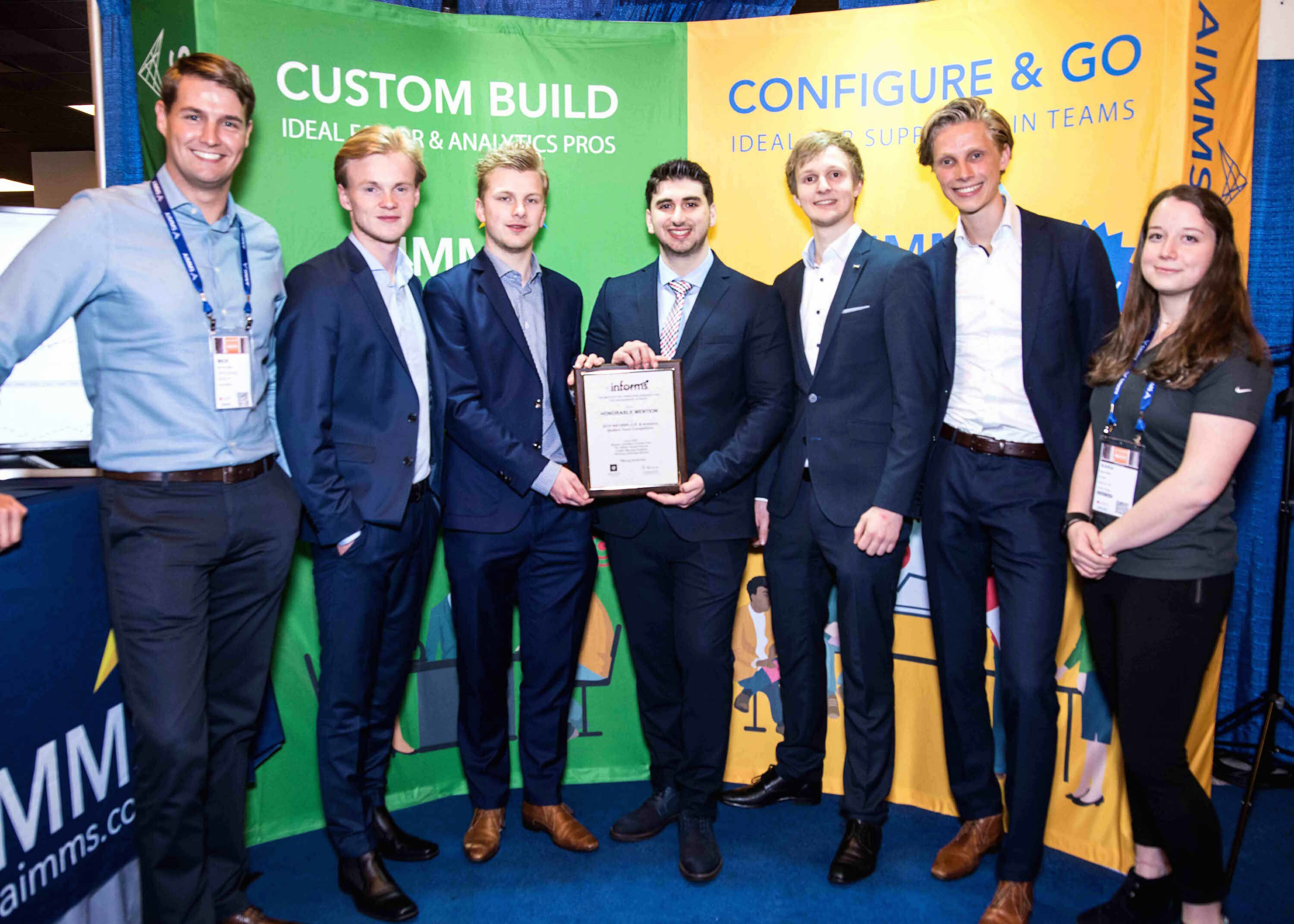Who We Are
First of all, let’s introduce ourselves. Our team is comprised by two Research Master students in OR (A. Selvi and L.M. Roebers), one Master student in Quantitative Finance and Actuarial Science (N.J. Simons) and two Master students in Business Analytics and OR (T.W.A. Fleuren and W.L.C. Faro). This year, we represented Tilburg University in the INFORMS 2019 O.R. & Analytics Student Team Competition. As one of the six finalist teams out of the total of 292 teams that participated, we were given the opportunity to present our work at the INFORMS 2019 Business Analytics Conference (Austin, Texas). During the project, our team was supervised by Associate Professor Dr. J.C. Vera - Lizcano.
The Challenge
The title sponsor of this year’s competition was General Motors (GM). Every day, GM ships out an average of 29,000 vehicles from 70 assembly plants to approximately 20,000 dealers by truck, rail and ship. These vehicles may go through one or more Vehicle Distribution Centers (VDCs) before reaching these dealers. We helped GM analyze how autonomous vehicles (AV) may change the finished vehicle and delivery operation process. The problem involved re-designing a vehicle delivery network with the adoption of AVs, including the operational routing for each plant-dealer-vehicle combination.
We used various techniques from Operations Research (MILP, Simulated Annealing) and Machine Learning (regression) guided heuristics. We analyzed several future scenarios to illustrate what GM could do to stay competitive in a changing business environment. We decreased the total costs in all future scenarios by providing strategic decisions with regards to the use of AVs, as well as daily operations within a dynamic network. The main strength of our solution is a significant decrease in overall lead time. We managed to halve delivery lead times compared to previous years.
Solution Approach
The problem included taking strategic high-level decisions, such as deciding where to open a VDC, as well as daily delivery decisions on the operational level. Therefore, we decided to split the challenge in two parts:
- Fixing network decisions
- Continuously optimizing daily operations given the network
The first planning stage, i.e. fixing the network design, must take future expected scenarios into account in order to obtain a robust plan in the second stage. We used GM’s datasets from previous years to analyze demand flows in the network, focusing on locations with significant average density. Then, using AIMMS software, we designed a network which minimizes the expected network costs. At this stage, we solved a Mixed Integer Problem by taking into consideration the VDC opening costs, VDC over-usage costs, VDC capacity allocation cost, transportation costs, and distances.
In the operational stage, we dealt with two routing problems: plant-VDC routing and VDC-dealer routing. We used the optimal network design from the first stage as an input and optimized two halves of the routing decisions sequentially. Each day, we obtained the information of the next two days’ delivery requirements along with vehicles ready for shipment today. If we had not taken historical demand into consideration during the first strategic planning phase, we would not have optimized plant-VDC routing, and VDC-dealer routing independently due to the curse of local optimality. However, the quality of the solution in the first stage, provided by AIMMS software, enabled us to divide the operational problem into two halves, providing enormous improvements in scalability at this stage. We then solved the plant-VDC problem using Mixed Integer Optimization and heuristics to speed up the optimization stage. In the VDC-dealer routing part, we used meta-heuristic Simulated Annealing to make optimal decisions about the order in which dealers from a VDC should be visited.
More information can be found in our team’s original report.
AIMMS software is particularly suited to build models that solve these kinds of strategic problems. AIMMS provides endless computational opportunities and a high level of interpretability and flexibility.
Use of AIMMS
AIMMS allowed us to come up with an excellent network design. Without the software, we wouldn’t have made it to the finals. The combination of user friendliness and outstanding computational performance made it a well-suited choice for this competition. AIMMS’ ease of use was vital not only in accomplishing this team effort, but also in other projects we worked on during our academic careers. Furthermore, the flexibility to quickly test new ideas, such as the possible introduction of new VDCs, proved to be fundamental in this competition. Testing new ideas was easy, as we could make minor changes to the model in the AIMMS environment. AIMMS provides endless computational opportunities and a high level of interpretability and flexibility.
The team and AIMMS Marketing & Sales Specialist, Kara Thrift
If you have any questions about the project, our solution approach or the use of AIMMS, leave a comment below.



